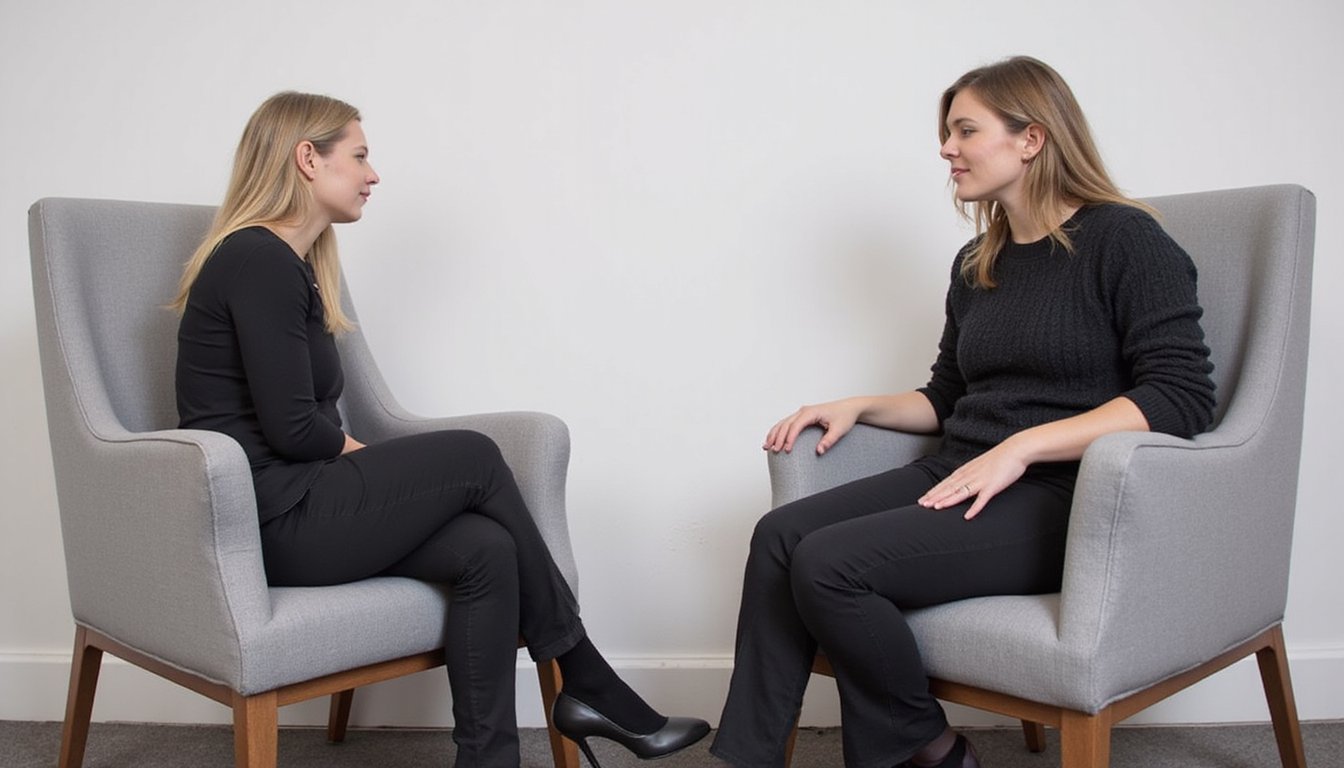Seven primary collaborative therapy techniques transform your mental health expedition through active partnership. You’ll establish trust with your therapist, co-create achievable treatment goals, and engage in regular progress checkpoints. The approach incorporates personal narrative exploration, solution-focused strategies, and motivational dialogue while tailoring evidence-based methods to your unique needs. Understanding these foundational elements can empower you to make the most of your therapeutic experience.
Building Trust Through Active Partnership

While establishing therapeutic relationships requires careful attention to multiple factors, building trust through active partnership forms the cornerstone of successful mental health treatment. You’ll find that fostering mutual understanding begins with consistent scheduling and clear confidentiality policies that create psychological safety. By engaging in reflective listening and validation, your therapist demonstrates deep engagement with your experiences while cultivating collaborative spirit through shared decision-making. Research demonstrates that therapeutic alliance consistently predicts positive outcomes in mental health treatment.
Trust-building exercises and open discussions about expectations help break down barriers and strengthen the therapeutic alliance. Your therapist’s culturally sensitive, non-judgmental approach acknowledges your unique background and values. Through active participation in your treatment process, you’ll develop a stronger sense of empowerment as your therapist affirms your strengths and resilience, creating an environment where authentic healing can flourish. Regular mindful breathing exercises practiced together with your therapist can enhance self-awareness and strengthen your connection. Sharing personal narratives about your identity and background through exercises like The Story of My Name can deepen the therapeutic connection and promote greater understanding between you and your therapist.
Co-Creating Achievable Treatment Goals
Setting clear treatment goals through collaborative planning guarantees you’ll have concrete benchmarks to measure your therapeutic progress. Research shows that young people experiencing anxiety or depression find small gradual goals particularly beneficial. You’ll work with your therapist to establish specific, achievable milestones that align with your personal recovery path and reflect meaningful life changes. The process is enhanced when you take the lead in identifying outcomes that matter most to your wellbeing. Regular goal review sessions help ensure your treatment stays on track and can be adjusted as needed. Together, you and your mental health provider will develop a structured framework that balances ambitious outcomes with realistic timeframes, creating a roadmap that promotes accountability and sustained engagement in your treatment.
Clear Goal-Setting Framework
Establishing a clear goal-setting framework stands as a cornerstone of effective collaborative therapy, where therapists and clients jointly develop achievable treatment objectives. The role of visual aids bolsters this process, helping you track progress and maintain focus on desired outcomes while empowering client autonomy through active participation. This collaborative approach creates a strong therapeutic alliance that research shows significantly predicts positive treatment outcomes. Setting goals in therapy provides clients with a meaningful roadmap for their personal growth journey.
| Component | Purpose | Implementation |
|---|---|---|
| SMART Goals | Provides structure | Define specific, measurable targets |
| Progress Tracking | Maintains accountability | Use charts and journals |
| Regular Reviews | Enables adaptation | Schedule periodic assessments |
| Communication | Builds understanding | Foster open dialogue |
| Support Systems | Guarantees success | Establish feedback mechanisms |
You’ll find that implementing structured frameworks like SMART goals, combined with consistent progress monitoring and open communication, greatly improves your therapeutic outcomes. This systematic approach helps overcome common barriers while maintaining focus on achievable objectives throughout your treatment path.
Milestone-Based Progress Tracking
Building upon clear goal-setting practices, milestone-based progress tracking transforms therapeutic objectives into tangible, measurable achievements. Through quantitative progress reporting and holistic stakeholder involvement, you’ll collaborate with your therapy team to break down treatment goals into specific, time-bound milestones that provide clear benchmarks for success. Leveraging systematic data collection through direct observation ensures accurate tracking of your therapeutic journey. Data-driven decisions help maintain ethical and evidence-based therapeutic interventions throughout your treatment. Regular SMART framework implementation helps establish achievable and realistic goals aligned with your progress.
- You’ll engage in standardized assessments and behavioral tracking to document your progress objectively, while visual tools help illustrate your advancement in the direction of milestones.
- Regular review sessions with your therapist enable data-driven adjustments to your treatment plan, ensuring interventions remain relevant and challenging.
- Your milestone achievements will be celebrated collaboratively with family members and other healthcare providers, fostering transparency and reinforcing positive momentum throughout your therapeutic course.
Partnership in Treatment Planning
When you actively participate in treatment planning, the therapeutic process transforms from a prescriptive approach into a dynamic partnership built on mutual trust and shared decision-making. By aligning client values with therapeutic goals, you’ll engage in a collaborative process that emphasizes identifying meaningful change through open dialogue and continuous feedback. The implementation of strength-based approaches helps reinforce your inherent capabilities and resilience throughout the treatment journey. Each disciplinary team provides diverse healthcare input to ensure comprehensive care coordination. The plan is typically established within three sessions to provide a clear direction for your therapeutic journey.
| Core Component | Your Role | Expected Outcome |
|---|---|---|
| Goal Setting | Express priorities & values | Personalized objectives |
| Progress Review | Share feedback & concerns | Plan adjustments |
| Strategy Development | Discuss preferred approaches | Customized interventions |
| Resource Integration | Identify support systems | Improved effectiveness |
| Timeline Planning | Define milestone targets | Measurable progress |
Your active involvement secures treatment goals remain specific, achievable, and relevant to your healing expedition, while regular evaluation allows for necessary adaptations as your needs evolve.
Implementing Regular Feedback Checkpoints
Regular feedback checkpoints set up the foundation for successful collaborative therapy by creating structured opportunities to assess progress and adjust treatment strategies. Through engagement optimization, you’ll benefit from standardized progress measures that amplify treatment outcomes with medium-to-large effect sizes. Clinical Support Tools enable responsive decision-making, helping identify and address challenges early in the therapeutic process. These systems are especially effective for patients who are not on track during treatment, showing stronger positive effects when compared to routine care.
- Use visual data and structured frameworks to track your progress, making it easier to understand and engage with your treatment path
- Participate in open dialogue during feedback sessions to build trust, reduce anxiety, and increase your motivation for positive change
- Experience personalized treatment adaptations based on your feedback, leading to targeted interventions and improved clinical outcomes supported by evidence (d = .44 to .85)
Exploring Personal Stories and Narratives

Personal stories and narratives serve as powerful catalysts for therapeutic change by helping you reconstruct meaning from life experiences. Through non-linear story progression, you’ll investigate unique outcomes, those exceptional moments when problems had less influence over your life. You’ll learn to externalize challenges as separate entities rather than inherent personal traits, reducing self-blame and shame.
The process involves deconstructing your narrative into manageable segments while examining intersectional identity discovery through cultural, social, and political contexts. You’ll engage in therapeutic storytelling to process difficult experiences and re-author your narrative, emphasizing strengths and resilience. This collaborative approach helps you recognize patterns, identify growth opportunities, and develop new perspectives. By examining your story’s components, you’ll gain clarity and empowerment to shape a more balanced, hopeful identity.
Identifying Solutions and Inner Strengths
Identifying solutions and inner strengths forms the cornerstone of collaborative therapy’s transformative approach. By highlighting unique skills and magnifying personal assets, you’ll work with your therapist to uncover inherent abilities that build resilience and self-efficacy. This process involves active behavioral observation and exploration of past successes to illuminate your distinctive coping strategies.
Collaborative therapy illuminates your innate strengths, helping transform challenges into opportunities through targeted self-discovery and personal growth.
- Your therapist will use strengths-based questioning to help you reflect on capabilities, asking targeted questions about what’s helped you overcome challenges
- Together, you’ll establish SMART goals grounded in your existing strengths, ensuring objectives feel achievable and personalized
- Through reframing techniques, you’ll transform negative self-perceptions into strength-based language, while consistent reinforcement helps expand your self-awareness and empowerment
Empowering Change Through Motivational Dialogue

Motivational dialogue serves as a cornerstone of collaborative therapy, leveraging the power of strategic conversation to catalyze meaningful change. Through the OARS technique, open questions, affirmations, reflections, and summarizing, you’ll guide clients in the direction of encouraging self-reflection while maintaining their autonomy in the change process.
This approach unfolds in distinct phases, beginning with engagement to build trust, then focusing on specific goals, evoking motivation, and ultimately planning concrete actions. You’ll utilize empathy and acceptance to validate your client’s experiences while fostering client autonomy through an egalitarian partnership. Research shows this method particularly excels in addressing ambivalence and promoting behavioral changes across different settings, from substance use treatment to healthcare adherence. By normalizing ambivalence and centering your client’s expertise, you’ll create an environment conducive to sustainable transformation.
Tailoring Evidence-Based Methods to Individual Needs
Effective mental health treatment starts with creating your customized tailored protocol that incorporates validated assessment tools and ongoing progress measurements. You’ll work with clinicians to blend multiple evidence-based approaches, such as CBT and Solution-Focused therapy, selecting methods that align with your specific needs and cultural background. Your active participation in cultural adaptations and treatment selections guarantees the therapeutic process remains responsive to your individual circumstances while maintaining clinical efficacy.
Personalized Treatment Protocol Design
Modern treatment protocols strike a delicate balance between standardization and personalization, with evidence showing that 30-75% of therapy sessions follow strict protocols while allowing for individual adaptations. Through modular protocol customization and fine-tuning interventions based on response, you’ll receive care that adapts to your unique needs while maintaining evidence-based foundations.
Key components of personalized protocol design include:
- Real-time assessment tools and web applications that collect your symptom data and preferences to guide treatment adjustments
- Multi-stakeholder collaboration involving clinicians, patient advocacy groups, and eHealth designers to guarantee protocols address practical needs
- Flexible frameworks that allow therapists to modify components based on your previous therapy experience, symptom trajectory, and current circumstances.
Integrating Multiple Therapy Approaches
Building on personalized protocol design, the integration of multiple therapy approaches amplifies treatment effectiveness through strategic combination of evidence-based methods. You’ll benefit from a data-driven decision making process that blends CBT, DBT, ACT, and Interpersonal Therapy to address complex symptom profiles.
Through theory-practice integration, your therapist will select and combine validated protocols based on your specific needs for anxiety, depression, substance use, or trauma. Research shows this multi-modal approach achieves better outcomes than single-modality treatments for many clients. Your treatment plan will adapt continuously through standardized outcome measures and symptom rating scales, ensuring ideal progress. This flexible, evidence-based framework allows for regular refinement of techniques while respecting your individual values, cultural background, and treatment preferences.
Cultural Adaptation Strategies
When adapting evidence-based therapeutic methods for diverse populations, cultural sensitivity becomes paramount through systematic stakeholder collaboration and targeted modifications. Through culturally informed interventions, you’ll bolster therapeutic effectiveness by engaging community leaders, clients, and cultural experts in the adaptation process. This stakeholder engagement solidifies interventions remain both evidence-based and culturally syntonic.
- Integrate cultural values, beliefs, and traditions into therapy methods while maintaining fidelity to core therapeutic principles
- Adapt language, metaphors, and assessment tools to match local dialects and cultural conceptualizations of mental health
- Monitor and adjust interventions based on continuous feedback from clients and community representatives, guaranteeing cultural relevance and therapeutic effectiveness
This systematic approach to cultural adaptation supports better outcomes by aligning therapeutic goals with cultural values while respecting community norms and practices.
Frequently Asked Questions
How Long Does It Typically Take to See Results in Collaborative Therapy?
You’ll typically see early progress within the first few months, though the complete expected timeline averages 20.4 months. Your results depend on collaboration quality – if you maintain strong therapeutic alliance, you’re likely to see faster improvements. Through client progress monitoring, you’ll notice changes aren’t always linear. While some clients show initial gains in symptom reduction, others may take longer, especially in complex cases requiring extended engagement.
What Happens if the Therapeutic Alliance Breaks Down During Treatment?
If the therapeutic alliance breaks down, you’ll likely experience trust issues that can hinder your progress. You might feel less motivated to attend sessions, share openly, or follow treatment recommendations. However, addressing conflicts directly with your therapist can lead to valuable conflict resolution opportunities. Research shows that successfully working through alliance ruptures often strengthens the therapeutic relationship and can actually improve your treatment outcomes when properly managed.
Can Collaborative Therapy Be Effective in Online or Remote Sessions?
Yes, you can expect collaborative therapy to be highly effective in online settings. Research shows that telehealth accessibility matches in-person treatment outcomes, with improvement rates of 80-86%. You’ll find that remote patient engagement often increases due to flexible scheduling and comfortable home environments. While building therapeutic relationships virtually requires specific adaptations, you can achieve similar alliance quality and treatment effectiveness through online platforms as you would face-to-face.
Are Medication and Collaborative Therapy Compatible Treatment Approaches?
Yes, medication and collaborative therapy are highly compatible treatment approaches with proven medication efficacy and collaborative therapy safety. You’ll find they work synergistically, as medications can help stabilize your acute symptoms while therapy provides you with essential coping skills. Research shows you’re likely to experience better outcomes when combining both treatments, as they address both the biological and psychological aspects of your mental health challenges. This integrated approach boosts your comprehensive recovery process.
What Role Do Family Members Play in Collaborative Therapy Sessions?
Family members play essential roles as active participants and supporters in collaborative therapy. You’ll find that family involvement includes providing emotional support, practicing improved communication skills, and helping implement treatment goals. When you’re supporting loved ones, you’ll engage in structured activities, share experiences, and work together to create a safe environment for healing. Multiple engaged family members can drastically reduce relapse risks while reinforcing the comprehensive support network.





